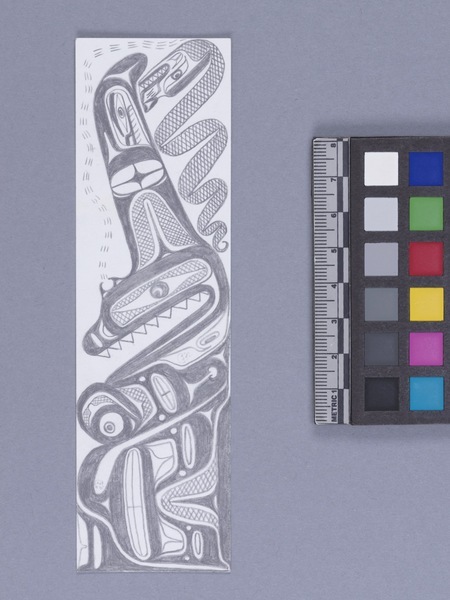Drawing Item Number: 3223/15 from the MOA: University of British Columbia


Description
A drawing on a white bookmark. The front-side is a vertically oriented and hand-drawn image of killer whale and a lightning serpent(?). The killer whale has an exaggerated dorsal fin decorated with an eye-shape(?) at the top, an elongated diamond-shape in the middle, and a crisscross pattern towards the base of the fin; the body of the killer whale is decorated with similar patterns. Two human skulls are also drawn on the whale's body, one directly under the head and the other towards the tail. The tail flukes are both decorated with an unshaded ovoid, two unshaded circles, and an arch with an inner tower-shape. A blowhole in front of the dorsal fin releases air. The lightning serpent(?) is drawn upside-down in the top right corner of the bookmark; its body is decorated with a crisscross pattern. The reverse-side of the bookmark displays an illustrated woman cradling a baby; below is the book title "Love You Forever," and the names of the authors and the publishing company.
History Of Use
These 62 small works (3223/1-62) comprise a collection of drawings in pencil, ink, pencil crayon, and felt pen made by the artist between the years 1968 and 2015. During that period the artist has identified himself by the following names: Ron Hamilton; Hupquatchew; Ki-ke-in; Kwayatsapalth; Chuuchkamalthnii; and Haa’yuups. The drawings are, for the most part, applied to the backs of bookmarks acquired from a range of bookshops; some are applied to other pieces of paper or cutouts from his earlier silkscreen prints. Many of the images represent killer whales, often in conjunction with accoutrements and symbols of Nuu-chah-nulth whaling. The juxtaposition of bookmark and representation of Nuu-chah-nulth himwits’a, or narrative, is a deliberate and meaningful placement of two distinct knowledge systems in relationship with one another. Ephemeral drawings like these were not created for the market; the artist has long made them for himself and sometimes as gifts for relatives and friends; they are a way of sharing his knowledge and experience about Nuu-chah-nulth ways of knowing, thinking about, and being in this world; they are expressive of what he calls kiitskiitsa: marks made with intention.
Item History
- Made by Ron Hamilton (Maker) in British Columbia, Canada between 1968 and 2015
- Owned by Ron Hamilton before November 8, 2016
- Received from Museum of Anthropology Acquisitions Budget (Funding source), Michael O'Brian Family Foundation (Funding source) and Ron Hamilton (Seller) on November 18, 2016
What
- Name
- Drawing
- Identification Number
- 3223/15
- Type of Item
- drawing
- Overall
- height 15.2 cm, width 4.4 cm
Who
- Culture
- Nuu-chah-nulth: Hupacasath
- Creator
- Ron Hamilton (Maker)
- Previous Owner
- Ron Hamilton
- Received from
- Museum of Anthropology Acquisitions Budget (Funding source), Michael O'Brian Family Foundation (Funding source) and Ron Hamilton (Seller)
Where
- Holding Institution
- MOA: University of British Columbia
- Made in
- British Columbia, Canada
When
- Creation Date
- between 1968 and 2015
- Ownership Date
- before November 8, 2016
- Acquisition Date
- on November 18, 2016
Other
- Item Classes
- works on paper
- Condition
- excellent
- Accession Number
- 3223/0015